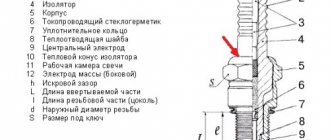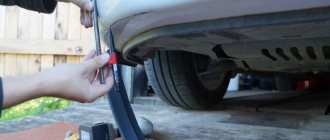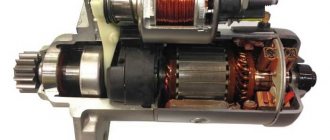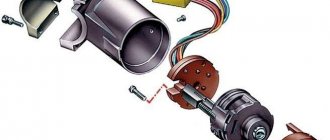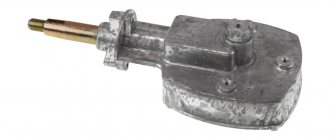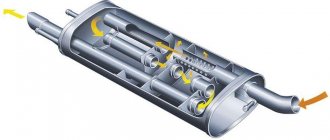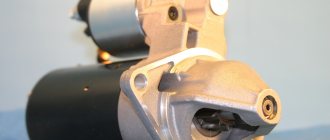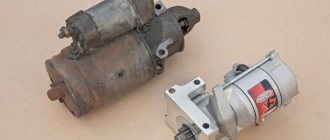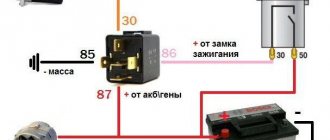The starter is a complex unit that is needed to start the car; it spins the flywheel, which in turn begins to spin the engine itself. But the starter cannot work without such a seemingly small, but very important element as the bendix, it is attached to the shaft and plays a very important role. But few people have heard about this small unit, and even fewer motorists have any idea how it works. Although many malfunctions are associated with it
Let's start with a definition.
The starter Bendix is a kind of gear that at a certain moment engages with the flywheel, spinning it; after the engine starts, this gear leaves. You need to say its “output” and the engagement controls the solenoid relay
To put it in simple terms, this is an improved gearing unit; it is, of course, not exactly a gear, but a whole mechanism.
Operating principle and features of the bendix mechanism parts
The drive gear with an overrunning clutch serves to ensure that the operation of the starter motor does not coincide with the engine speed. Both parts rotate synchronously, together with the armature shaft in only one direction. In the other they rotate freely. Moreover, this indication does not depend on the state of the armature, which is located in such a part as the starter. Bendix on domestic Volga-made cars is a roller tool that works on the wedge principle.
When this device is actuated, the armature revolutions are transmitted to the outer race of the clutch. The outer ring begins to rotate relative to the inner one. Often the last part remains stationary while the Bendix is running, because the gear is in connection with the flywheel of the idle engine. Under the influence of friction, the rollers move to the narrow part of the wedge space, thereby separating both cages from each other. Thus, the starter bendix drives the armature, while simultaneously driving the flywheel.
It should also be noted that this part has a special retractor spring and inclined splines in its design. They serve to ensure that the starter bendix comes out of the connection with the flywheel wreath. These parts are installed on the armature shaft. The hub moves along them to meet the rotation of the engine.
How does bendix work on the starter?
The starter Bendix is a relatively simple part and has a long service life. Structurally, Bendix includes:
- drive race (outer ring);
- driven clip;
The drive cage with rollers and pressure springs has characteristic wedge channels with a large width on one side. Spring-loaded rollers rotate in such channels.
When the rollers reach the narrow part of the channel, they are locked between the driving and driven cages. The springs actually “push” the rollers into the narrow part of the channel.
Bendix starter device
The main elements of the drive are: driven cage with gear - provides clutch with the flywheel; drive cage - located on the starter armature shaft and rotates with it; buffer spring - softens the moment of contact of the gear with the flywheel crown (sometimes the clutch does not occur the first time and thanks to this spring the gear bounces back and engages again); rollers and pressure springs - allow the gear to rotate in only one direction (if the rollers wear out, the gear will slip when the engine starts).
Most often, breakdowns occur due to wear on the teeth of the starter drive gear. In this case, you have to remove the starter and replace the Bendix, although in some stores you can find repair kits in which the gear is sold separately. Be that as it may, repairing a starter without proper preparation is quite difficult. Less often, the buffer spring weakens. It is also easy to make sure that it has weakened - when you turn the key in the ignition switch, you can hear a grinding noise. The engine will start, but such a misalignment of teeth will lead to rapid wear of both the Bendix gear and the flywheel crown (and repairing it will cost much more than replacing the Bendix).
Also, the cause of the breakdown may be a break in the bendix fork, which connects the bendix to the solenoid relay. If this fork breaks, the overrunning clutch gear will not engage with the flywheel. Over time, the rollers located in the drive holder can also wear out. They look very small, but it is thanks to them that the gear can only rotate in one direction. If the gear rotates freely in all directions, then this indicates either a defect or complete wear of the rollers and weakening of the pressure plates. It is worth saying that the starter is a rather complex device and breakdowns most often do not occur due to the Bendix. The service life of the starter is significantly less than that of the engine, so sooner or later it will still have to be replaced.
Design and principle of operation
Most overrunning clutches (let's call them the more popular word among motorists - bendix) consist of a driving race (or outer ring) containing rollers and pressure springs, as well as a driven race . The leading holder has wedge channels, which on one side have a significant width. It is in them that the spring-loaded rollers rotate. In the narrow part of the channel, the rollers are locked between the driving and driven clips. As is clear from the above, the role of the springs is to drive the rollers into the narrow part of the channels.
The principle of Bendix operation is the inertial effect on the gear coupling that is part of it until it engages with the engine flywheel. While the starter is inoperative (the engine is turned off or running in constant mode), the Bendix clutch is not engaged with the flywheel crown.
Bendix works according to the following algorithm:
Bendix interior
- The ignition key is turned and current from the battery is supplied to the starter motor, driving its armature.
- Thanks to the helical grooves on the inside of the coupling and the rotational movement, the coupling, under its own weight, slides along the splines until it engages with the flywheel.
- Under the action of the drive gear, the driven cage with the gear begins to rotate.
- If the teeth of the clutch and the flywheel do not coincide, it rotates slightly until they are firmly engaged with each other.
- The buffer spring included in the design serves to soften the starting moment of the engine. In addition, it is needed to prevent tooth breakage from impact when the gears engage.
- When the engine starts, it begins to rotate the flywheel at a higher angular speed than the starter previously rotated. Therefore, the coupling twists in the opposite direction and slides along the splines of the armature or gearbox (in the case of using a geared bendix) and disengages with the flywheel. This saves the starter, which is not designed to operate at high speeds.
How to check starter bendix
If the starter bendix does not turn, then you can check its operation in two ways - visually , by removing it from the car, and “by ear” . Let's start the description with the latter, as it is simpler.
As stated above, the main function of the bendix is to engage the flywheel and spin the engine. Therefore, if at the moment of starting the engine you hear that the starter motor is spinning, and characteristic metallic clanging sounds - this is the first sign of a Bendix malfunction .
So then it is necessary to dismantle the starter and disassemble the bendix in order to inspect it in detail and determine the damage. The removal and replacement procedure is described below.
And so, the bendix was removed, it is necessary to inspect it. In particular, check whether it rotates only in one direction (if it turns in both, it means it needs to be replaced) and whether the teeth are eaten. Also check to see if the spring is loose. You should also remove the fork from the Bendix, check its integrity, signs of wear, and if necessary, replace it. In addition, be sure to check if there is any play on the armature shaft. If this occurs, then the bendix should be replaced.
Principle of operation
It's time to study the principle of operation of the Bendix, because we have already become familiar with its structure and some of its features. We will try to explain in a simple and easy-to-understand manner how the Bendix of a car starter works. This process occurs as follows:
- The gear meshes with the engine flywheel. To start the latter, you need to reach at least 50 rpm.
- The starter is designed exclusively for short-term loads, therefore it cannot provide the required speed. When starting the car, a high load may be placed on the starter, which will cause damage to it.
- Thanks to the Bendix, you don’t have to worry about the condition of the starter if the ignition is not released immediately after starting. This overrunning clutch will act as a kind of insurance. It will prevent the transfer of torque from the engine to the starter.
- At the moment the torque of the power unit increases and its indicators exceed the indicators relative to the starter, the bendix goes into idle cranking.
Starter in analysis
It is extremely rare that something breaks in a Bendix. And yet such situations can occur. As you might have guessed, options for identifying breakdowns and the reasons why they occur will be further studied.
Possible causes of failure
As mentioned above, gear rotation is only possible in the direction of rotation of the starter armature. If rotation in the opposite direction is possible, this is an obvious malfunction, that is, the bendix must be repaired or replaced. There may be several reasons for this:
- Reduction in the diameter of the working rollers in the cage due to natural wear. The way out is to select and purchase balls of a similar diameter. Some car enthusiasts use other metal objects, such as pieces of a drill, instead of balls. However, we still do not recommend doing it yourself, but buying balls of the required diameter.
- The presence on one side of the roller of flat surfaces formed due to natural wear. Repair recommendations are similar to the previous paragraph.
- Grinding the working surfaces of the driving or driven race in those places where they come into contact with the rollers. In this case, repair is hardly possible, since such excavation cannot be removed. That is, it is necessary to replace the bendix.
Note! It is often better to completely replace the bendix than to repair it. This is due to the fact that its individual parts wear out approximately equally. Therefore, if one part fails, the others will soon fail as well. Accordingly, the unit will have to be repaired again.
Another reason for failure is wear of the gear teeth. Since this happens for natural reasons, repair in this case is impossible. It is necessary to either replace the mentioned gear or the entire Bendix.
Since the starter not only experiences heavy loads, but also comes into contact with the external environment and is susceptible to irritants such as moisture, dust, dirt and oil, freewheeling can also occur due to deposits in its grooves and rollers. A sign of such a malfunction is the noise of the armature when the starter is started and the immobility of the crankshaft.
Basic faults
Well, guys, personally, in the distant past, when I still had a VAZ 2101, I first encountered a Bendix malfunction. It manifested itself as - you turn the ignition key, but nothing happens, that is, the engagement appears, but the engine does not spin up. This malfunction is called upper part slippage.
As I already wrote, it should only rotate in one direction, but over time, the rollers or pressure springs wear out, and there is no wedge when engaged - the bendix begins to rotate in the other direction! That is, it rotates freely on the shaft.
Many workshops simply change this unit, that is, they follow the path of least resistance, but it can be repaired, and with your own hands.
How to remove, clean, disassemble and what to lubricate?
Let's consider one of the simple but effective ways to clean the clutch: remove the starter from the vehicle; The removed part must be immersed in a container with gasoline for 2-3 hours. This will help clean it thoroughly from dirt; to clean the coupling grooves from deposits accumulated inside them, it is necessary to rotate its gear without removing the device from the container with gasoline; Now you can take out the device, and then thoroughly wash its body.
If such a measure does not give the desired result, it will be necessary to remove and disassemble the coupling. Let's look at how to change the Bendix on the starter: Open the hood and remove the minus terminal from the power source, thereby completely de-energizing the vehicle's on-board network. After which it is necessary to remove the power wires from the solenoid relay and the starter housing and begin dismantling it. Unscrew the fasteners that hold the element. Please note that to remove the element, you will most likely have to dismantle the adjacent parts. We assess the condition of the flywheel.
To replace the overrunning clutch, you will have to completely disassemble the starting device of the power unit. First, you should remove the cover, then remove the fastener from the traction relay winding and pull out the washer. We remove the fasteners, after which the engine starting device is disassembled into two halves. It happens that there is a ball inside it, it is advisable not to lose it. Since the starter is in a disassembled state, it is worth diagnosing all its components and, if they malfunction, replace them.
We dismantle the traction rod, the rubber insert and the retaining washer to gain access to the remaining small parts of the device. We release the protruding part of the bendix by prying it with a screwdriver, after which it is necessary to dismantle the lock washer or ring located on the shaft. We remove the worn out bendix and install a new element in its place. Litol is ideal as a lubricant. If it is missing, you can get by with motor oil. Everything is assembled in reverse order.
Why does the starter need Bendix?
The Bendix, or overrunning clutch, serves to transmit rotation from the starter to the engine crankshaft and spin it up. The design of the Bendix is such that after the engine has been successfully started and it begins to rotate independently, its gear is disconnected from the crankshaft and the starter stops working. Despite the high-quality steel from which the Bendix is made, its teeth wear out over time, which leads to difficulties when trying to start the car - the gear simply slips and is unable to engage the crankshaft flywheel.
Problems with the Bendix are eloquently evidenced by the situation when, when you turn the ignition key, the starter begins to rotate, but the crankshaft remains motionless and the engine does not start. To independently diagnose an overrunning clutch, many car owners use a simple but extraordinary method. After dismantling the starter and fixing it in a vice, it is connected to the battery. Take a wooden block and rest it on the bendix of the working starter. If it is fully operational, the block will begin to wear off, but if the bendix stalls and the starter continues to rotate, the overrunning clutch will have to be replaced with a new one.
Some tips from experienced drivers
Here are some tips from experienced motorists that will help you avoid possible problems and inconveniences when repairing or replacing a Bendix:
- Before installing a new or repaired bendix, always check its operation and the drive of the unit.
- All plastic washers must be intact.
- When buying a new Bendix, it is advisable to have the old one with you in order to verify their identity. Often similar parts have minor differences that are not visually memorable.
- If you are disassembling a Bendix for the first time, it is advisable to write down the process on paper or put the individual parts in the order in which they are dismantled. Or use the manual with photographs, video instructions above, and so on.
Bendix replacement and starter repair
Bendix starter for VAZ 2110
To repair the starter, the following tools are required:
- spanners;
- heads in a set;
- several screwdrivers;
- insulating tape;
- new bendix.
When is it time to change the bendix?
During the operation of VAZ 2110 cars, sometimes drivers may notice low starter efficiency, which affects the functionality of the engine; as a result, the car simply does not start the first time.
For example, if, when starting the “tens” engine, the driver hears a slight crackling sound and feels the starter sticking, you cannot do without replacing the bendix, in other words, the overrunning clutch.
Price issue
Finally, it’s worth adding that Bendix is an inexpensive spare part. For example, a Bendix VAZ 2101 (as well as other “classic” VAZs) costs about $5...6, catalog number is DR001C3. And the price of Bendix (no. 1006209923) for VAZ 2108-2110 cars is $12...15. The cost of Bendix for FORD cars of the Focus, Fiesta and Fusion brands is about 10...11 $. (cat. no. 1006209804). For TOYOTA Avensis and Corolla cars Bendix 1006209695 - $9...12.
Thus, repairs are often impractical for Bendix. It's easier to buy a new one and simply replace it. Moreover, when repairing individual parts, there is a high probability of rapid failure of others.
Overrunning clutch design
When the driver turns the ignition key, the retractor relay pushes the bendix forward, its gear engages the crankshaft flywheel and begins to spin it. The fuel ignites in the combustion chambers and the engine starts. As soon as the crankshaft begins to rotate faster than the starter armature, the overrunning clutch will immediately separate the gear and flywheel.
How does bendix work?
It consists of:
- inner race with gear;
- housings with an outer ring;
- rollers with springs;
- sealing washer;
- retaining ring.
The gear may have 9 teeth, 10 or 11 teeth. There is a more complex geared bendix.
The outer (driving) race of the bendix is tightly fixed to the armature and transmits rotation from it to the inner (driven) race. The clutch occurs due to spring-loaded rollers. The gear on the driven cage engages the crankshaft flywheel and spins it, the fuel ignites in the combustion chambers, and the car starts. To do this, the flywheel and crankshaft must rotate at a frequency of at least 100 rpm. per minute Since the Bendix gear is 10 times smaller than the flywheel, it needs to spin 10 times faster, that is, at 1000 rpm. per minute When the engine starts, it starts running at 1000 rpm. per minute It turns out that now the flywheel should turn the starter armature, and also 10 times faster (10,000 rpm). But Bendix prevents this. When the speed of rotation of the crankshaft exceeds the number of revolutions of the electric motor, the springs stop putting pressure on the rollers, the clutch between the inner and outer races disappears, they begin to rotate at different speeds, this saves the starter from jamming.
How to find out if the starter bendix is working properly
You can check this in two ways: by first removing it from the car or by ear. The second method is simpler. If, when starting the engine, the starter rotates, but the engine does not start, and a metallic clanging sound is clearly heard, then the starter bendix is faulty.
If you still had to remove the starter, you need to carefully inspect the overrunning clutch. Signs of breakdown that you should pay attention to:
- does it rotate, as intended, only in one direction;
- whether the teeth of the gear are worn out;
- does the bendix sit tightly on the armature splines;
- is there any wear on the drive holder and rollers;
- Have the springs lost their elasticity?
You can change individual clutch parts, but usually the Bendix units wear out at the same time. Auto service technicians advise not to save money and buy a new device.
How to replace bendix on the starter
You can repair the Bendix starter yourself. To do this, you will need metalworking tools: socket and socket wrenches, screwdrivers, sliding pliers, chisel, hammer.
How to remove bendix from starter
We unscrew the starter; if there is no gearbox, then carefully knock the washer off the armature and remove the retaining ring. Remove the bendix from the axle. We replace it with a new one, which we install in the reverse order. The most difficult part is installing the washer and retaining ring. For this, craftsmen use clamps, special wrenches, and sliding pliers. Replacing the bendix on the starter requires some practice.
Sometimes a malfunction occurs due to dirt getting into the mechanism and there is no need to disassemble the starter; you can try to revive it. To do this, the anchor with the overrunning clutch is dipped in a container of gasoline for 5–7 hours and the gear is periodically turned. Afterwards, the starter needs to be dried thoroughly and tested. If it does not work, then disassembling the unit cannot be avoided.
What do car mechanics advise?
Before removing the starter and changing the bendix, make sure that the battery is charged. There are funny cases when the problem was not in the overrunning clutch, but only in a discharged battery.
Don’t skimp on small things - be sure to install only a new washer and retaining ring.
When going to the store, don’t be lazy to take your old Bendix with you. Sometimes, at first glance, absolutely identical couplings differ in minor details.
Before installing the bendix, thoroughly rinse and lubricate all rotating parts and armature splines.
When disassembling the starter, write down the sequence of actions. This will make it easier to assemble the unit.
Before installing the starter, check it. To do this, take two wires that are used to start cars in cold weather. Connect the “minus” to the body, the “plus” to the contact on the solenoid relay. If the starter is working properly, a characteristic click will be heard and the overrunning clutch will move forward.
Bendix analogues
You might be interested to know that a Bendix-like part is also used in manual transmissions. Especially in situations where the car is driving down a mountain. But Bendix variations are widely used not only in cars. As mentioned above, such a device is used in bicycles, as well as in the design of helicopter propellers. In fact, the device can help in any mechanism during startup.
The most important thing is to choose the right one and change the Bendix parts on time. Now you finally know what a starter bendix is and you will no longer torment yourself with this question. And since this is truly one of the key parts, every motorist should understand its operation and design. Always replace Bendix parts on time and make sure that it is not filled with unnecessary debris, then you will feel safe on the road.
What is bendix in the starter?
This incomprehensible word refers to an overrunning clutch, which provides parallel rotation for the gear and flywheel. With such a mechanism, starting the car is silent, and the starter lasts much longer. Do not think that the Bendix in a car is just a gear that is responsible for the rotational actions of the flywheel. Although, this is precisely the opinion that inexperienced drivers often have.
The Bendix starter device was invented by the American Vincent Bendix. Bendix began to be called that after the name of its inventor. This invention was a real discovery, which changed a lot in the world of technology, in particular in the automotive industry. Surprisingly, modern parts work on the same principle as they did more than 100 years ago.
Bendix is not only used in car starters. This part is also present in bicycles (ratchet), helicopter rotors and all mechanisms that need to be started. Let's get back to cars. Here this part is located directly in the starter housing. This mechanism works from the moment the car starts until the power unit stops completely.
The standard bendix is arranged as follows:
- two clips (slave and drive);
- casing;
- washer;
- a set of rings, including a retaining ring;
- pressure spring with rollers;
- buffer spring;
- support cups.
In other words, bendix is presented in the form of two flat steel rings, between which cylinders/balls are located. The last structural elements are supported by springs. On the inner ring there are grooves in which the cylinders are located. It is due to the special shape of the holes that the rings can rotate smoothly in the opposite direction, but at the same time jam when moving forward.
